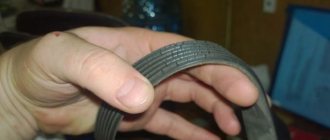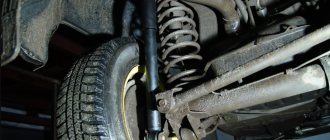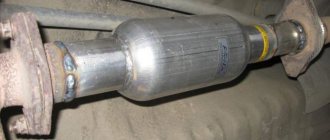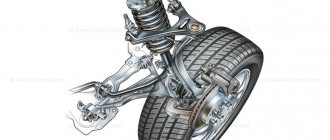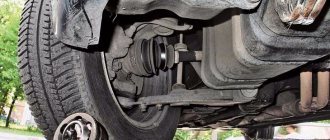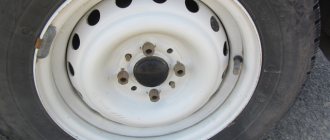The absence of a spare tire or a standard “dokatka” seriously complicates the situation. If the driver has the skills, you can put a temporary patch on the puncture, otherwise you will have to order a tow truck.
We recommend taking with you a spare tire, a repair kit for different occasions, and the necessary tools, then you can get out of any road situation with dignity. If all this is missing, then you can drive a short distance to a service station or tire shop on broken tires. We are not talking about hundreds of kilometers of travel, we are talking about a short distance.
When can you drive on a flat tire?
As you already understand, it is absolutely forbidden to drive on a completely flat tire.
But there are exceptions to any rule. There are special run flat wheels on sale; they have very rigid sidewalls that allow you to continue driving even with a completely flat tire at speeds of up to 80 km/h. Unfortunately, the price of these tires is much higher than usual. But if the quality of your roads leaves much to be desired, and you have to travel long distances by car, I recommend purchasing them. Overview of the benefits of RunFLat tires, now you can drive with a flat tire:
Consequences of driving on a half-flat tire
If the driver has not noticed problems with tires for a long time and has driven several kilometers in this condition, it is important for the motorist to know what to do with his tires now. Many argue that it should be thrown away. Photo: patticc.com
However, many experienced drivers and tire service workers advise trying to preserve the tires, especially if they were purchased not so long ago.
Some drivers, even when a tire goes flat, do not change it for a new one, but simply pump it up regularly. It is worth noting that this measure is temporary - you will still have to buy a new tire
Alternatively, you can tape the cut area (if it is not very large).
As for tubeless tires, in this case you can install a tube - then the rubber will not leak. You can also apply a special protective layer - tire glue is used for this.
Why does the tire go flat?
The safest option is tubeless tires; most cars produced today are equipped with them. If a puncture occurs, the pressure in the tire does not drop immediately, but remains for some time. There are many examples when drivers did not notice for several months that a nail was stuck in one of the tires. However, this situation is only possible in case of minor damage. A tube tire, on the contrary, instantly loses pressure when damaged. If this happens at speed, then it is extremely difficult to avoid an accident. Car owners are recommended to choose safe tubeless options.
Is it possible to repair a flat tire?
This question can be answered after identifying the reasons for the decrease in tire pressure. The tire will not require immediate repair if the problem is a minor breakdown of structural parts (a dent on the disk, a valve has failed, etc.). If a hole appears in the tire, then driving on such a flat tire becomes uncomfortable. Possible solutions to the problem depend on whether the cause was a puncture or cut.
The consequences of a puncture are eliminated according to the following scheme:
- Using a car compressor, the tire is inflated a little more than usual. Firstly, it is more convenient to work with a well-inflated tire. Secondly, the hissing sound makes it easy to determine the puncture location.
- The hole is widened using a spiral awl, screwing it into the puncture and removing it. The procedure is repeated several times to make it more convenient to perform the next step and place a tourniquet in the puncture.
- A piece of tourniquet, the length of which reaches 4 cm, is inserted into a special awl with an eye. The awl should divide the tourniquet in half.
- Using an awl, the tourniquet is gradually placed into the prepared hole until it stops.
- Afterwards, the tool is sharply pulled out, the tourniquet remains in the hole, and its ends are cut off.
If the flat tire is in the front, then access to the tire is easy by simply turning the steering wheel in the right direction. The wheel on the rear axle will have to be removed for repairs. After eliminating the consequences of the puncture, the tire is put back in place and checked how well it holds air. If the hissing sound is no longer heard, then you can safely drive to the car service center. Although some car owners stop at the above procedure, considering it sufficient. Experience shows that a puncture repaired in this way does not interfere with the further operation of the car.
When a wheel is cut, a different tactic is used. This damage is more serious than a puncture. This problem can arise after hitting a sharp object or when meeting with hooligans. In case of a cut, it is better to immediately put on a spare tire and take the flat tire to a service station. The craftsmen will check the depth and volume of the cut. Depending on this, a decision will be made about repair or its inappropriateness.
Causes of pressure loss
Air leakage from a car tire can occur in different situations. In this case, it is not necessary to punch through; there are other unforeseen and unpleasant situations. The most common:
- A puncture is the most common accident on the road. In this case, the situation may worsen if the puncture is slow, that is, a sharp object is stuck in the tire and the air comes out very slowly, the driver will find out about this later, when it is completely deflated. In this situation, if you identify a puncture, you can slowly drive to the tire shop, after pumping up the air.
- A cut is a more serious problem than a puncture. The size of the damage is larger, air flows out faster and the tire flattens almost instantly. In this case, damage can occur to both the main part of the tire and the side part. The side part is thinner and easy to cut. Particularly dangerous in this regard is careless driving on the side of the road, near curbs, and in ruts with sharp edges. Once a tire is cut, it is practically impossible to repair; it only needs to be replaced with another one.
- Malfunction of the valve (spool) - this also occurs. You can simply tighten it with a wrench, otherwise you will have to change the part.
- The source of air leakage from the wheel is the nipple - it can be treated by simply tightening it.
Potholes or unevenness on the road can create a serious problem. Hitting such an obstacle at high speed can lead to deformation of the car rim and subsequently damage to the rubber. This is a very serious damage that cannot be corrected on your own without the use of special equipment; you need to go to a tire repair shop.
Use of worn-out car tires - it is necessary to adhere to the service life specified by the manufacturer. Otherwise, the wheel may go flat due to excessive wear. There is a risk of explosion during operation.
Problems exist with tubeless tires - the fitting sometimes does not fit well to the rim, and air leaks occur.
The main reasons that lead to damage to car tires and air leakage are indicated. Whether it is possible to drive on a flat tire is determined by the driver himself, taking into account his experience and capabilities.
How to feel a flat tire when driving?
If the driver has not carefully checked the wheels before driving long distances, then while driving he should listen to sounds and feel some unusual movements of the car when driving. Depending on the reason for the flat tires, the car may behave differently, but one way or another, manifestations uncharacteristic of normal driving will appear:
- The vibration will change;
- Additional sounds appear in the form of tapping, humming, noise, etc.;
- The body may sway unusually;
- The car seems to be pulled to the side;
- Depreciation is reduced;
- You can feel a beating in the steering wheel, which may intensify as the speed increases;
- Driving the car becomes more difficult;
- Increased fuel consumption and so on are noticeable.
If you feel something strange in the behavior of your car, look for a safe place to park and inspect it.
What can happen when driving on half-empty wheels?
Under the weight of the car, the side profiles of the tire are compressed and begin to wear out and get cut by the edges of the disc. The internal frame is damaged. The shoulder areas of the tread wear out faster due to improper contact patch with the road. Fuel consumption increases as the tire loses its rolling resistance properties. At a speed of 30 km/h, an empty or half-flat tire can become dismounted, which will lead to damage to the disc. Scraps of rubber can damage the integrity of the locker and fly off into oncoming cars. The car becomes hazardous.
What are the dangers for your car and tires when driving on a flat tire?
Every driver should be aware of the seriousness of the situation so that there is no temptation to ignore a leaky wheel. Any delay will only aggravate an already dangerous situation. On a flat tire you can only get to the nearest tire shop. But nothing more.
A tire is not a piece of rubber placed on a rim. It is a complex structure in which every detail plays its role. Car rubber consists of several layers. To produce each of them, a special fiber is used and special technologies are used. Even the tread pattern is not created for beauty. A team of specialists is working on its development; numerous tests are carried out to ensure that the functionality of the drawing is maximum.
If the wheel is leaking air, then its functionality is impaired. When driving on such tires, the following situations arise:
- decreased depreciation, which leads to the car driving to the side;
- as the speed of movement increases, the existing imbalance becomes more obvious and vehicle control becomes more difficult;
- increased fuel appetite of the car;
- a flat tire comes into contact with the asphalt with the side part, which is not intended for this, since it has little strength - this can lead to the rupture of the entire rubber;
- the work of the cord is disrupted, which is not able to properly distribute the load along the perimeter of the tire, this leads to the formation of hernias;
- when the wheel is completely deflated, high pressure occurs on the disc, and the rubber ruptures completely;
- deflated tires can fly off the disk, causing it to become deformed;
- a significant decrease in vehicle controllability, which is especially noticeable when performing sharp maneuvers.
Now you can tell for yourself whether it is possible to drive with a flat tire. The situation is very clear. But what to do if there is no other way out and you really need to get to a tire station under your own power?
Next we have to figure out how long you can drive on a flat tire and how to do it correctly. This information will be useful to every driver, because no one is immune from the occurrence of such a problem.
Is it possible to drive on a completely flat tire and why is it dangerous?
Tires have a rather complex structure. They consist of a number of elements, and the design of each of them is thought out to the smallest detail. A multilayer tire is also created from a whole complex of different materials. At the same time, the side and central parts have different density indicators, for example.
Let's imagine a situation where a motorist simply has no choice, and he continues to drive with one flat. In this case, the damaged wheel does not provide shock absorption, so the car constantly deviates to the side. In this case, you cannot develop speed at all. Indeed, as it increases, the intensity of the deviation from the course also increases, which is fraught with an accident. You need to drive at minimum speed.
Also, if you have a flat tire, you need to be prepared for rapid fuel consumption. The contact patch grows, the side of the tire touches the asphalt, which may suffer from this. Then the wheel will be completely damaged. Also, in the absence of air, the cord does not work, and the load does not distribute. Therefore, hernias appear very quickly. And even if they can be eliminated later, the wheel will not last long. Soon you will have to buy a new one.
Also, if you drive half-flat, it can quickly deflate completely, after which the rubber will tear and all that remains is to throw it away. If the tire is completely deflated, it may fall off, and then the disk will also suffer.
In any case, when driving with at least one half-flat tire, you should forget about sudden maneuvers or high speed. In principle, you can drive a short distance if the situation is forced and there is no choice. But it is worth remembering all the risks and precautions. You also need to know that you cannot drive on a completely flat tire. You'll have to stop and pump it up regularly.
What pressure is most comfortable for movement?
Often, when a car passes obstacles in an area where there is no road, qualified drivers reduce the pressure in the wheels to 0.5 atm. This amount of air is enough to travel at low speed, a distance of several kilometers. There is one thing, it’s not worth going on a long journey, as the tire will wear out. Also, the side projector tends to wear out.
Drivers who frequently drive a car consider it unacceptable to have cuts on their tires; they try to immediately see the problem of low pressure long before the wheels finally go flat. Therefore, when they go to a store that sells spare parts, they buy kits, which may include flagella and awls for various installations. With these items you can fix a puncture in the tire and have time to get to your destination. The flagella can withstand a total pressure of 2.2 atm.
If the materials cannot be purchased, there is a method with a self-tapping screw; it is screwed into the place where there is a hole in the wheel. This can be found at home in almost every family. Used to stop wooden panels. The self-tapping screw prevents air leakage. It can last about two days. With this device you can travel hundreds of kilometers. The pressure is maintained up to 2.2 atm. In this state, the car can easily travel to various tire service centers.
Consequences of driving on a flat tire
The consequences of driving on damaged tires will depend on several factors - distance and degree of damage.
- a flat or half-flat tire causes increased fuel consumption;
- tires that are not completely deflated are very poorly absorbed, therefore, when driving, the car will drift in the direction where this wheel is located;
Must remember! The higher the speed, the greater the drift to the side, and the greater the risk of a rollover.
- even a short ride on damaged tires destroys the tire;
- with significant movement, over a long distance, the rubber will completely fly off the disk and the disk will eventually have to be thrown away;
Very important! A damaged wheel reduces the vehicle's handling by orders of magnitude.
It is not recommended to drive on a damaged tire. But there are situations when there is no other choice. And in order to minimize the negative consequences, you need to know how to do this:
- no fast driving, only slowly and carefully;
- It is best to choose a more or less even coating;
- keep the situation under control, periodically exit and check the condition of the disk;
- if the tire is completely flat, the distance it will travel before complete destruction is approximately 10 kilometers;
How long can you drive on a flat runflat tire?
Tires made using Runflat technology have reinforced sidewalls, due to which the tire does not jump off the rim and reliably holds the weight of even a 2-ton car. But even such a wheel needs repair after damage. You can drive with a puncture on Runflat at a speed of no more than 80 km/h; the total length of the journey should ideally not exceed 100 kilometers.
There is also a more advanced version of these tires. Manufacturers not only strengthen the cord, but also install polyurethane half rings. This is done for additional stability in case the car gets into a minor traffic accident.
Driving on runflat tires is not as ideal as it might seem. Just read the comments of owners of “puncture-free” tires on specialized automotive forums. The main negative aspects that are mentioned in most comments: excessive rigidity and poor handling. Runflat is not a cheap product, but for owners of expensive cars this criterion is not significant. Driving on Russian roads on runflat tires is not a good idea. Shaking on such tires is felt very intensely, large irregularities are felt especially sharply. A coarser cord does not hold traction well. Because of this, the response from the steering wheel slows down, and vibrations are transmitted more easily to it. This is especially noticeable when turning.
Driving on run-flat tires is the same as giving up comfort and handling. Manufacturers of such rubber, in order to reduce the negative effects of tires, advise installing them only on cars with suspension prepared for bad roads. In addition, wheels with runflat tires are very noisy.
Another nuance is more critical: few car services, with the exception of those in large cities, can provide services for restoring damaged tires. If you plan to travel to distant Russian regions, then be prepared for the fact that the local tire shop will not be able to help you. You shouldn’t count on the handymen on the sidelines either. Unfortunately, the spare tire is not included in the Runflat kits.
Situation 3. The tire went flat very quickly.
For example, due to a breakdown of the sidewall. In this case, it will still not be possible to revive the tire for further use. So you can drive tens of kilometers to the tire shop at a speed of 40 km/h. But keep in mind that around 15 km, a punctured and flat tire will begin to smoke, crunch and fall apart. Pieces of rubber can damage the apron, locker or plastic of the bumper. So don't let this happen.
If you increase your speed or drive on gravel rather than asphalt, a torn tire will wear out much faster.
When driving a car with such a wheel, avoid sudden movements and sudden changes in trajectory. Otherwise, you may lose control of the car, and the rubber on the rim may spin, which will accelerate its destruction.
By the way, you can last longer on a flat tire in winter rather than in summer. In the cold season, the tires will take longer to warm up to a critical temperature, so you will drive further on them.
Source
Is it possible to drive on a flat tire?
Editor's answer 0 + - If one tire is punctured, most drivers immediately solve this issue by installing a spare wheel or a spare tire. But two or even three wheels cannot be replaced instantly. One spare tire is not enough, and you don’t want to bother with it. Many people simply take a compressor and pump air into the tires; fortunately, a small hole lets in less air than the compressor forces inside the tire. In this case, you can raise the pressure to an acceptable level and drive to the tire shop before the air escapes.
Questions and answers How to quickly repair a punctured tire yourself?
But if the cord is cut, the hole expands under the pressure of air and then the tire does not hold pressure at all. The most desperate people roll to the workshop at their own peril and risk. What happens to the rubber?
The tire quickly loses elasticity under cyclic loads that occur when driving with zero pressure. In fact, she finds herself between a rock and a hard place. The disc pushes the rubber onto the asphalt and cuts it. In addition, unexpected loads arise in the horizontal plane, which do not exist in an inflated wheel. The disc pulls the rubber, the cord breaks, and with it the internal fibers of the material spread out. As a result, the tire is “chewed up.”
If you remove it from the wheel and look inside, you will find black dust. This removes the surface protective layer. If there is little dust, then the wheel still has a chance to live, but if it has dirty everything around, then most likely the tire will be recycled. When the tire is inflated, hernias similar to blisters appear in places of damage. Moreover, they can come in a chain, like bug bites. This tire is no longer suitable for use. She was killed by a voyage in a deflated state. Moreover, to damage the cord, it is enough to drive a couple of hundred meters.
In addition, if you drive on a flat tire and accelerate to 30-40 km/h, the empty tire will simply fly off the rim and hit the asphalt and sides of the car like a rag. Then there is a risk of scratching the paintwork and even denting the metal of the body. In the worst case, the disc will bend or crack on uneven surfaces. Therefore, any movement is permissible only on inflated wheels, with the exception of specialized run-flat tires with rigid sidewalls. These wheels can roll when completely deflated for a distance of up to 80 km, but they can only be found on expensive premium cars. Will you be fined for driving with a flat tire? More details
What pressure is considered acceptable for movement?
Usually, when driving through off-road obstacles, experienced jeepers reduce the pressure in the wheels to 0.5 atm. This amount of air is quite enough for driving at low speed over a distance of several kilometers. However, you can’t go far like that, because the tire wears out quickly. Its side protector is wearing out.
Experienced drivers do not drive with punctures and try to detect a drop in pressure by the behavior of the car even before the tire is completely deflated. They run to the spare parts store for a repair kit, which includes flagella and a special awl for installation. With such a flagellum you can plug the puncture and inflate the wheel to working pressure, and then go to the service center. The flagella can withstand a standard pressure of 2.2 atm.
If you can’t get a repair kit, you can screw a thick self-tapping screw into the hole, such as are used in everyday life for fastening wooden panels. The self-tapping screw plugs the air leak and can last a couple of days. You can travel hundreds of kilometers with it. Well, it can withstand pressure at the level of 1.5-1.9 atm.
If, before installation, you coat the self-tapping screw with sealant and first pump it into the puncture, you can increase the pressure to 2.2 atm. In this condition, the car will reach any tire service station.
How to get to a tire shop if a tire has burst
When creating a mandatory first aid kit for victims in a car, you must also not forget about the “medicines” intended directly for the vehicle itself. Along with a jack and keys, special tools should be available to solve the problem of damaged tires. Do not think that using a sealant or any other means can completely restore a tire, regardless of the degree of damage and the nature of the “wound”. Of course this is not true. The manufacturer provides a guarantee for the use of funds in the following cases:
- if there is a puncture on the tires;
- if the diameter of the “wound” does not exceed 6 mm.
If all points are met, then you can use the available product. To do this, you need to perform the following manipulations:
- Install the tire so that the valve is at the bottom.
- Unscrew the spool.
- Pour in the product.
- If necessary, use a pump and inflate the tire.
Sealants contain substances whose distinctive feature is complete hardening upon contact with air or any other gas. Thus, the chemical reaction occurring at the puncture site ends with the formation of a kind of “plug” that prevents the tire from deflating.
So that the car enthusiast does not worry about how long he can drive on a flat tire, tire manufacturers offer their consumers new and improved technologies. Thanks to this, tires have appeared that can continue driving after a puncture.
The ability to drive “on a flat tire” appears with tires that have been upgraded in one of the following areas:
- A support tire has an elastic ring that is installed on the rim and provides additional support for a flat or punctured wheel.
- Load-bearing tire, or “zero pressure tire”. Thanks to its special composition, its rubber is reliably protected from the heat that inevitably occurs during movement of a punctured wheel. This is also facilitated by the ribs protruding on the sides of the wheel. In general, the technology comes down to increasing the strength of the sidewall and frame. To use such tires, the owner must have a tire pressure monitoring system.
- A self-sealing tire is reinforced with a protective inner layer that contains sealants that can regenerate small holes in cases where the rubber is damaged while the vehicle is in motion.
Runflat tires, unfortunately, are not without their drawbacks:
- Despite the increased cost compared to the price of a regular tire, they are practically irreparable.
- Runflat operation is only possible with a system that controls the pressure level.
- The reinforcing effects not only increase the tire's reliability, but also its overall weight. This circumstance affects the overall driving characteristics of the vehicle.
Each of the listed methods for eliminating a puncture makes it possible to safely get to the auto center.
Issues discussed in the material:
- Why does the tire go flat?
- Is it possible to drive on a flat tire?
- How long can you drive on a flat tire runflat?
- Is it possible to repair a flat tire?
On the road, a motorist may encounter a number of unexpected and unpleasant situations. A punctured tire promises considerable difficulties if the car does not have a spare tire or special chemicals that can temporarily heal the puncture in the tire. Is it possible to drive on a flat tire? Let's look at it in detail in our article.
How to inspect a wheel?
But no matter the extent of the flat tire and whatever the reason for this, the first thing a driver in such a car must do is find a safe place and stop. And then:
- Raise the car with a jack;
- Inspect the surface;
- Use thin material to detect a foreign body (the material will get caught);
- When inspecting, rotate the wheel by hand;
- To understand where the air is coming from, you can inflate the tires and determine by ear;
- You can apply a soap solution and identify a cut or puncture by the bubbles.
These methods will make it clear to the driver the nature of the malfunction and the level of the problem.
What to do if a tire goes flat?
So, let's consider a situation where it suddenly turns out that one of the wheels, for example, is broken. What to do in such a situation? The best solution would be to immediately replace it with a spare tire. But to do this, you must have a spare wheel with you. You can also temporarily solve the problem if you have with you a set of tire repair harnesses or specialized auto chemicals that are sold in cans. It is sprayed into the wheel and then the tire can usually hold air again. It is advisable to have such a tool with you. It will help you get to the tire shop.
However, let’s consider a situation where there are no wheel replacements or special means. In general, you can try driving with a half-flat tire if you follow certain rules. So, you need to drive at minimum speed. Any sudden maneuvers should be avoided. You cannot drive on uneven roads; potholes and bumps must be somehow avoided. It is also worth getting out of the car regularly, assessing the situation and pumping up the tire. It is worth keeping in mind that a rare tire can withstand more than 10 km of driving in this mode. Therefore, it is more advisable to still call a tow truck. Experts also advise not to take risks, but to call him. After all, tires are quite expensive and in any case it makes sense to try to repair them. Especially if you bought it recently. Operating a damaged wheel always increases risks and often leads to relative or complete disrepair and shortens its service life several times over.
Pumping is not a solution to the problem. Even if the tire goes flat just a little, you need to contact a car service center. After all, this problem can get worse at any moment.
Is it possible to drive with a flat tire?
Sometimes you have to drive a hundred or two meters before you find a suitable place to stop. In such a situation, you should not feel sorry for the already damaged tire and try to stop in the middle of the road, creating a threat to vehicles driving behind and nearby. There is no need to even doubt whether it is possible to drive on a flat tire.
It is most prudent to overcome the necessary part of the road and stop in a place where you can do the inspection without disturbing anyone.
After stopping and inspecting the tires, it is important to decide what is the easiest and fastest way to eliminate the problem.
For the sake of objectivity, it is worth admitting that without proper skill and certain experience, replacing a wheel is quite problematic.
The arriving team will provide quick, qualified assistance. If there is no spare tire, rescuers will help to tow the vehicle to one of the vehicle repair and maintenance centers.
The unsightly aspects of such a decision may include the following factors:
- long wait for auto mechanics;
- increase in the amount of payment for the provision of services.
Based on this, the conclusion suggests itself: the ability to independently arrive at the technical center will help save money.
A tire breaks: what to do?
The most dangerous situation is a tire breakdown at high speed. If the damage is large, the air will immediately leave the tire, causing loss of control. The car skids towards the broken wheel, so to maintain a level course the driver should turn the steering wheel in the opposite direction. Don't try to brake, this will only make the skidding worse. Simply release the gas; a flat tire will quickly slow down the car. Then all you have to do is stop on the side of the road. Try to find a safe place where you will not interfere with other road users.
If the wheel is seriously damaged, the only option is to replace it with a spare one or a replacement one, which must be in the car, especially if you are driving somewhere far away. There should also be a jack and a wheel wrench in the car. First you need to loosen the wheel with a wrench, and then raise the car on a jack. The jack should rest on a flat, hard surface; place stones or other heavy objects under the other wheels to prevent the car from rolling. Next, all that remains is to unscrew and remove the wheel, and then install the spare one.
Replacing a wheel is a rather labor-intensive task, so in the case of a minor puncture, you can do it easier: inflate the wheel with a pump and carefully drive to the nearest tire repair shop. If the damage was caused by a self-tapping screw or other similar object, with increasing pressure the object can completely close the hole, and you can easily get to the desired place. You can try to repair a small puncture yourself. For this, there are special repair kits consisting of tools for cleaning the hole, an awl and a tourniquet. Another option is to use a sealant. They are sold in cylinders, which are connected to a nipple using a special hose. The sealant pumped into the tire will plug the hole.
Consequences of driving on a half-flat tire
If for some reason you decide to postpone replacing tires and continue to drive with half-flat tires, then you need to be prepared for unpleasant consequences:
- the braking system operates with low efficiency, which is especially noticeable during emergency braking;
- turns are accompanied by skidding of the car, and sharp maneuvers completely deprive the driver of the ability to control his vehicle;
- reduced dynamics and resistance to aquaplaning;
- rapid wear of the steering;
- accelerated and final failure of the tire due to overheating of the rubber;
- a high probability of getting a punctured tire every time a wheel hits a hole, even a small one;
- high fuel consumption is associated with increased wheel rolling;
- reduced service life of the tire, which begins to get damaged while driving;
- detachment of cord threads, which leads to annular fracture.
Driving on a flat tire is permissible only in extreme cases, when it is not possible to revive the tires or install a spare tire. Such a car is dangerous because it reacts poorly to steering.
What is the danger of a flat tire while driving?
If a hopeless situation arises and you have to continue driving on a flat tire, then negative processes arise in the car, which after such a drive may require deeper and more radical repairs:
- Ball joints;
- Suspension silent blocks;
- Shock absorbers;
- Bearings, in particular hubs;
- Steering rods and racks - when the front wheels are deformed;
- Shock absorption systems;
- Tires due to a ring fault;
- For complete replacement of rubber in case of swelling and rupture;
- To replace a disk after its deformation;
- Brake system, etc.
When driving on a flat tire, the tires may explode and the car will suddenly skid; the brakes may also fail or the steering may weaken - the driver must be prepared for any unpleasant surprises.
Depending on the type and degree of damage to the wheel and regardless of the distance, driving on a flat tire leads to the repair of not only the wheel itself, but also various engine systems and the car as a whole.
Is it worth starting repairs on the road yourself?
If you don’t have a spare tire, but you need to somehow get to the service center, then it is advisable to carry out a simple repair that will simply allow you to get to your destination on a flat tire, for this:
- We find the cause of the problem;
- If air flows through the valve, then place the tire so that the nipple is at the bottom;
- Unscrew the spool;
- Fill in the sealant;
- We pump up the wheel.
A jack and a wheel wrench will help you change the tire yourself, although on most cars the tire bolts are installed in tire centers using air guns.
If you don’t have any sealant or even a jack with you, then there is only one way out - call a mobile service service, which will tow it to the nearest car service center.
Is it possible to drive on a flat front tire and for how long?
Depending on the drive of the car, a decision will be made on the road whether it is possible to drive on the front flat tire or whether it is better to replace it with the rear one.
So, in cars today there are different options for transmitting power and torque from the engine to the drive wheels:
- Rear drive;
- Front-wheel drive;
- All-wheel drive is available on crossovers, SUVs and modified passenger cars.
If you have a front-wheel drive model, then the tire wear on the front axle is many times greater than on the rear axle, since the loads on the wheels also differ.
The front wheels also suffer from increased load caused by the heavy power unit installed at the front. And the steering increases wear on the front wheel tires much more.
Therefore, if the front wheels on front-wheel drive cars puncture, you should replace the wheels and put the rear wheels forward. If the car is rear-wheel drive, then this is not advisable.
Tire pressure standards
If the driver does not know what pressure is considered normal for the tires of his brand of car (most often this picture is observed among beginners), then he should study the operating instructions supplied with the vehicle.
You can also use special summary tables, and as an example it is worth citing data that is relevant for domestic models.
See also:
Causes of tire noise while driving
Keeping your tires in check is just as important as wearing your seat belt, and there are a number of good reasons for doing so.
Reasons for a flat tire
All about sedansMoreover on the topicComments
Tubeless tire
But no matter how good and reliable a wheel with a tubeless tire is, it can also go flat. Reasons why a tire goes flat:
- puncture;
- a cut;
- peeling of the tire from the disk;
- bleeding through the spool or nipple;
Tire puncture
It is stated above that a tubeless wheel is capable of not flattening even with several punctures, but this is only possible if the element that punctured the tire remains in it. The inner surface of the tubeless is coated with a special viscous compound that sticks to the nail, screw, wire and prevents air from leaking out. But if the pierced object is pulled out, the viscous composition will not be able to close the hole and the air will come out.
Therefore, if a foreign object is found in the tire, do not rush to pull it out. It is better to leave it in place and continue to operate the car, and once you have reached the service station, remove the protruding element and seal the puncture site.
But it happens that after a puncture the object does not remain in the wheel and such a tire will go flat. The rate of air release depends on the size of the damage. In some cases, tire deflation occurs so slowly that the loss of half the air pressure occurs over several days. With such a puncture, you just need to periodically pump up the tire and continue driving the car, and contact a service station as soon as possible. But slow descent does not always happen. If a large hole is formed (for example, when hitting reinforcement), the wheel will deflate in a matter of minutes.
A cut
Tire cuts are less common than punctures. And such damage appears on the sidewalls, since it is difficult to cut through the working surface of the tire. The most common cause of a cut is sharp objects and protrusions catching on the side. A cut means serious damage to the wheel. For minor cuts, you can still try to restore the wheel (at a service station), but if the size of the cut is long and through, then the tire must be replaced. Note that some service station workers offer to restore a wheel with a severe cut, but it is better to refuse this service. When cut, the cord is damaged and its integrity cannot be restored. Even if the tire does not go flat, it can “shoot” at any moment while driving, and this phenomenon is very dangerous.
Peeling
Peeling of the tire from the disk occurs when strong impact loads on the wheel lead to deformation of the disk. This happens when you fall into a hole at speed. A strong blow causes the impact energy to reach the disk and the metal bends. As a result, the tire no longer fits tightly to the rim and air escapes through the resulting gap. This problem did not exist in tubed tires, and flexing of the rim did not cause the wheel to go flat (provided the tube remained intact upon impact).
Disk deformation and bleeding through the spool
Valve device for tubeless tires
Disc deformation is a problem that cannot be eliminated under road conditions. The geometry of the part can be restored only on special rolling machines available at service stations. Wheel flattening through the spool occurs quite often. The defective element is unable to hold air. Here it is enough to replace the spool and pump in air again. But if air etching occurs at the place where the nipple is installed, then a visit to a tire shop cannot be avoided, since it is necessary to glue the nipple, and for this the wheel will be disassembled.
Something else useful for you:
- Spacers to increase disc offset - which ones are better to install?
- What is a spare tire and how does it differ from a regular spare tire?
- How is the chassis of a car arranged?
For what reasons can a tire go flat?
There are many reasons why tires can start to deflate. The most common situations are the following:
- A puncture or cut in the rubber is the most common reason why a tire may lose air. The greatest danger is a sharp object that remains in the tire. In this case, the air deflates slowly, and the driver is not aware of the problem until the tire is completely deflated.
- The spool may leak air. In this case, you can try to tighten it using a special wrench. If this does not help, then you will have to change the part.
- The nipple can also allow air to pass through. The problem can be easily solved - you just need to tighten it up.
- Deformation of the disc as a result of hitting a hole or hitting a hard surface, most often a curb. In this case, the tightness of the connection between the rubber and the disk is broken and the wheel releases air along the rim.
- Old tires with a high degree of wear often leak air. Driving on such tires is dangerous, so it is necessary to replace them as soon as possible.
- On tubeless tires, the fitting may leak air due to its loose connection to the disc.
How to insure yourself?
But such extremes can be avoided if you always carry a spare tire and a jack in the trunk. Having a tire pressure monitoring system installed in your car won't hurt either.
As soon as the pressure drops, the driver receives a signal that will warn him long before an emergency that he needs to change his trajectory and go to a car service center.
Even if there is no such signal, attention to the movement and behavior of the car can make it clear that there are problems with the tires.
Knowing your car and paying attention to it will help you avoid breakdowns and accidents.
Prevention or how to extend the life of wheels?
Of course, you should think about prevention even before purchasing wheelsets - start monitoring the price and quality of wheels suitable for your model, read forums and opinions of experts. And opt for the highest quality and most durable pairs.
And also monitor the health of your car and follow the rules:
- Do not overload;
- Do not pick up speed sharply;
- Do not suddenly reduce speed;
- Avoid uneven roads;
- Monitor the road surface;
- Have a spare tire in the trunk;
- Have the necessary tools for emergency road repairs;
- Pay attention to movement;
- Before leaving, inspect the wheels;
- Change tires on time;
- Change shoes in seasons, etc.
It is possible to avoid an accident due to flat tires; it is important to take care of your tires and carry out preventive inspections on time.
